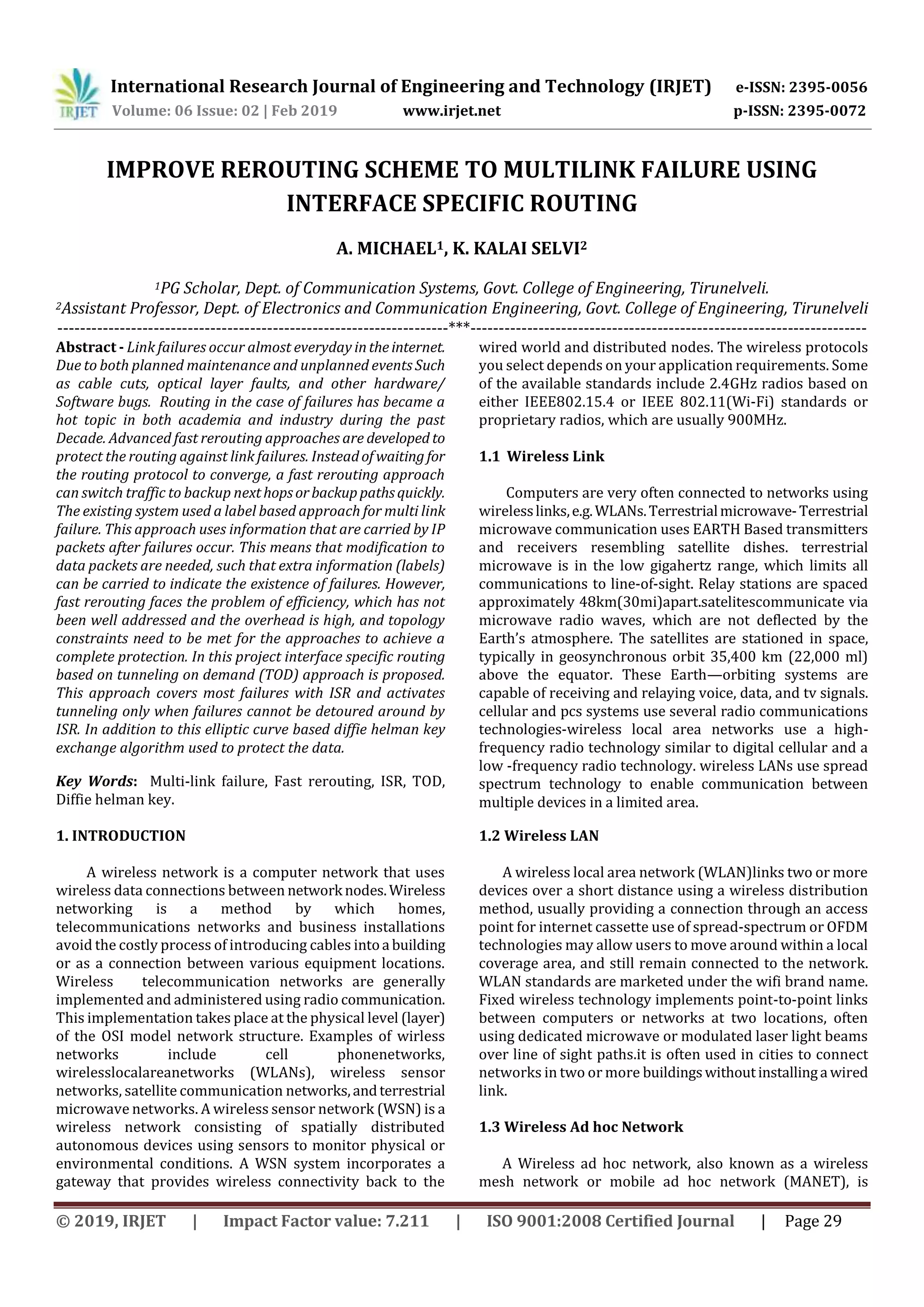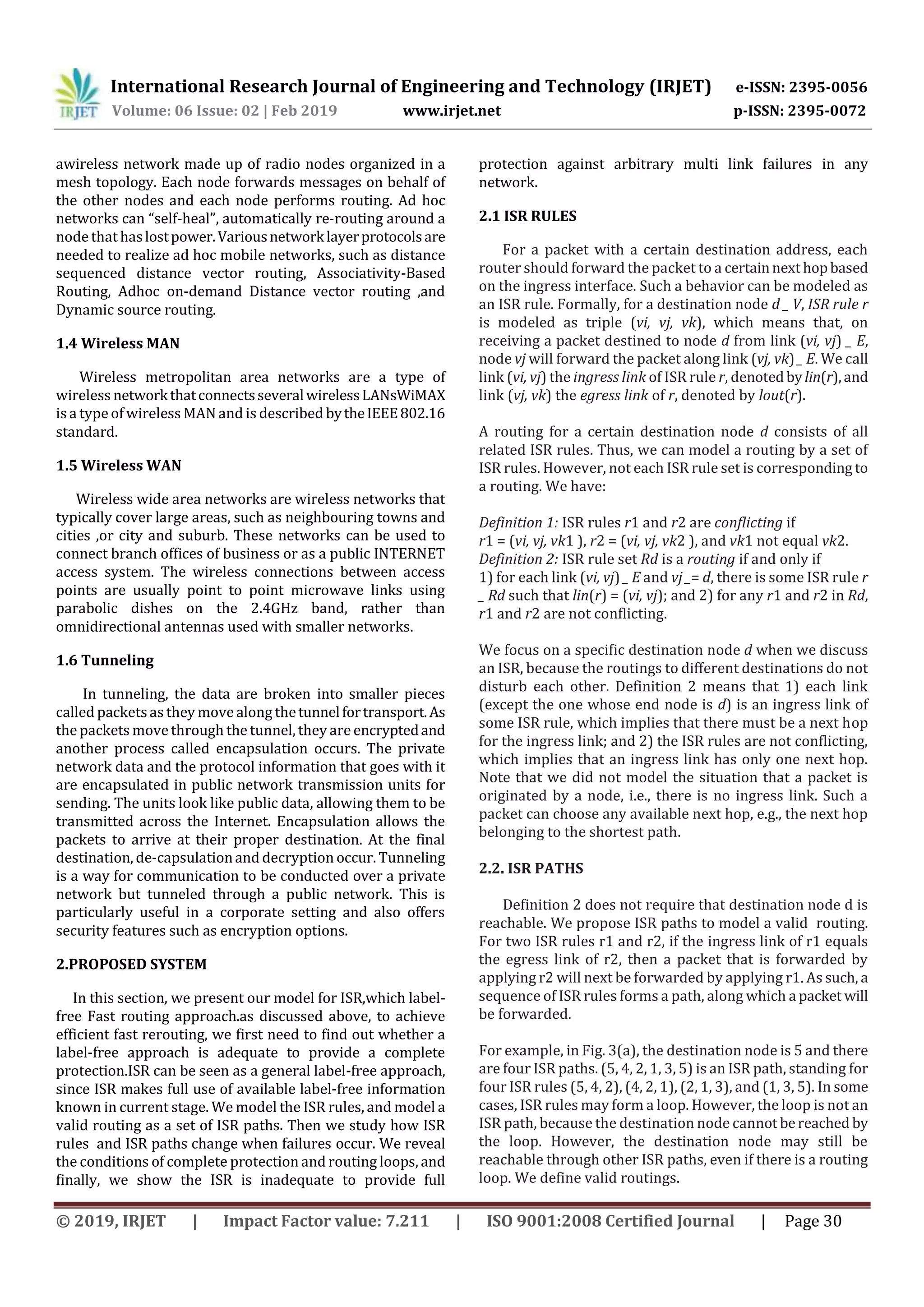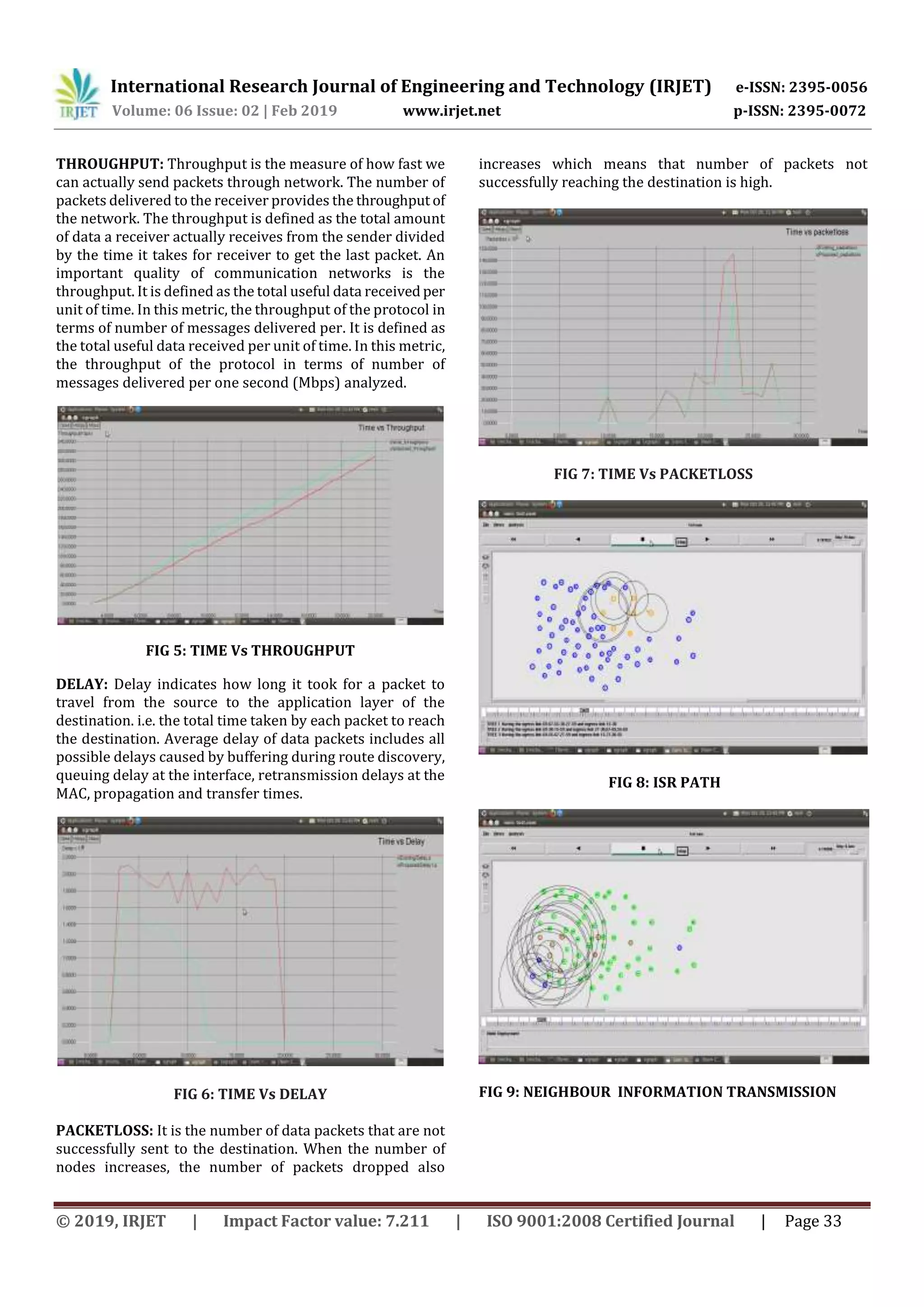This document discusses improving rerouting schemes for multiple link failures using interface-specific routing (ISR). It proposes using ISR combined with tunneling on demand (TOD) to cover most failures. ISR routes traffic based on the ingress interface of packets, avoiding the need for packet modifications. TOD is only activated when failures cannot be routed around with ISR alone. The document also discusses using elliptic curve-based Diffie-Hellman key exchange to encrypt data for added security.


![International Research Journal of Engineering and Technology (IRJET) e-ISSN: 2395-0056
Volume: 06 Issue: 02 | Feb 2019 www.irjet.net p-ISSN: 2395-0072
© 2019, IRJET | Impact Factor value: 7.211 | ISO 9001:2008 Certified Journal | Page 31
FIG 1:Example Of ISR PATHS, Node 5 is the destination.
(a) w/o failures.(b) link (1; 3) failed. (c) link (4; 5) failed.
2.3.Adjusting Routing For Link Protection
A packet is forwarded to a backup next hop when the
premier one fails. There can be different strategies to select
the backup next hop,i.e.,the backup egress link. When there
are multiple candidates. We propose the reverse rule
forwarding(RRF)strategy. WechooseRRFbecauseanyother
strategy can be reduced to RRF in certain situations. After
that will show how ISR paths change when a link fails. With
RRF,a packet whose egress link is failed will be forwarded as
if it is received from the reverse link of that egrees
link.formally,assume a packet is received by node vi from
node vh,and there is ISR rule (vh,vi,vj).if think (vi,vj)is
failed,we will find ISR rule (vj,vi,vk)todealwiththepacket.as
such, the two ISR rules(vh,vi,vj)and (vj,vi,vk)arecombinedto
a new ISR rule,i.e.,(vh,vi,vk).
Fig -2: An example of ingress &egress link selection
strategy.
Which shows a part of a network and node 5has degree 2.
When link (5, 6) fails, node 5 has only one nexthop to use,i.e.
node 4. And then, node 4 will forward a packet to node 3
according to ISR rule (5, 4, 3). Because node 4 is notaware of
the failure, any egress link selection strategy in node 4 will
not be triggered, so node 1 or node 2 will not be selected as
the next hop.
2.4. Protection Effectiveness Limit of ISR
Now we show the limit of ISR-based protection. The
result is negative: there exist some networksin whichnoISR
can be constructed to protect the routing against all k-link
failures (k _ 2). Formally, we have the following theorem.
Theorem 1: There exists network G such that, for any ISR Rd
for G, at least one of the following holds: 1) Rd is not a valid
routing; or 2) there exist at least one multi-link failureunder
which the resulting network is connected but the resulting
routing is not a valid routing.
Proof: We prove the theorem by showing one such network
that meets the conditions. The network topology isshown in
Fig. 5(a), where node 1 is the destination node. We consider
all possible cases when two links in set {(6, 7), (8, 9), (10,
11), (12, 13), (14, 15), (16, 17), (18, 19)} are failed
simultaneously. Note that only the failure of links (6, 7) and
(8, 9) will make the network unconnected.First,forall nodes
except node 1, the ingress link of an ISR rule cannot be the
egress link, or else a routing loop will be Second, the node
degree of nodes 2 to 5 is 3. For each of these nodes, if there is
an ISR rule (vi, vj, vk), then (vk, vj, vi) cannot be used, or else
a routing loop will be induced when link failure occurs,
according to Theorem 9. Thus, there exist only two possible
cases of ISR rules in a node with degree 3, as shown in Fig.
5(b). Since there are 4 nodes with degree 3 in our network,
there are only 24 = 16 possible ISRs in total. We can then
check the routing validness one by one, and check the
potential routing loops underfailuresfollowingForinstance,
one possible ISR is shown in Fig. 5(c). We can see that there
are two routing loops, and destination node 1 cannot be
reached from nodes 18 and 19, so the ISR is not a valid
routing. By checking all 16 possible ISRs, we find that either
the ISR is not a valid routing; or there exist at least one
multilink failure (except the failure of links (6, 7) and (8, 9))
that cannot be protected. This ends our proof.
Fig. 3: Network used in the proof of Theorem1.(a)
The network topology. (b) Two possible ISR-rule cases
for a node with degree 3 in the network. (c) One of all
possible ISRs where node 1 is the destination.
2.5 TUNNELING ON DEMAND APPROACH
We discuss the considering two broad categories of fast
rerouting separately,namely label-freeapproachesandlabel-
based approaches. Label-free approaches use information
that can be obtained within traditionIPpacketforwardingto
select a backup next hop. Such information include
destination address, local failures, next hop andbackupnext
hops computed in advance [3], and the interface from which
a packet arrives [4]. The overheadoflabel-freeapproachesis](https://image.slidesharecdn.com/irjet-v6i206-190309072008/75/IRJET-Improve-Rerouting-Scheme-to-Multilink-Failure-using-Interface-Specific-Routing-3-2048.jpg)
![International Research Journal of Engineering and Technology (IRJET) e-ISSN: 2395-0056
Volume: 06 Issue: 02 | Feb 2019 www.irjet.net p-ISSN: 2395-0072
© 2019, IRJET | Impact Factor value: 7.211 | ISO 9001:2008 Certified Journal | Page 32
little because packets are not required to be labeled, but the
protection performance is in turn limited. For instance, the
Loop-Free Alternates approach can protect the routing
against any single-link failure only if the network topology
meets certain conditions [5]. For multi-link failures,wehave
not seen any label-free approachthatcanprovidea complete
protection even against dual-link failures.Ontheotherhand,
label-based approaches use information that are carried by
IP packets after failures occur. This means that modification
to data packets are needed, such that extra information
(labels) can be carried to indicate the existence of failures.
The labels can have different forms such as special flags [2]
or extra (tunneling) headers [6], [7], but they all introduce
extra processing overhead and delay the packet forwarding.
Since label-free routing (ISR) cannot provide a full
protection against multi-link failures for any network
according to Theorem 1, it is natural to take a label-based
approach, while minimizing the labeling overhead. The
tunneling on demand (TOD) approach in this section. TOD
uses ISR to protect the routing against most (or all if
possible) multi-link failures, and uses tunneling only for the
cases that cannot be covered, and our goal is to use as few
tunnels as possible. To realize the idea, we first need a
proper ISR that can cover most multi-link failures. If not all
multi-link failures can be covered by the ISR, we need tofind
out which multi-link failures can induce routing loops,sowe
can establish protection tunnels for them.
2.6 ELLIPTIC CURVE DIFFIE HELLMAN KEY
The Elliptic Curve Diffie-Hellman (ECDH), is an
anonymous key agreement protocol that allows two parties,
each having elliptic-curve public-private key pair, that have
no prior knowledge of each othertoestablisha sharedsecret
key over an in-secure channel. This shared secret may be
directly used as a key, it can then be used to encrypt
subsequentcommunicationsusinga symmetric-keyciper.[1]
It is a variant of the Diffie-hellman protocol using elliptic-
curve cryptography. In a shared secret is a piece of data,
known only to the parties involved, in a secure
communication. The shared secret can be a password, a
passphrase, a big number or an array of randomly chosen
bytes. In contrast to a secure channel, an insecure channel is
unencrypted and may be subject to eavesdropping. Secure
communications are possible over an insecurechannel if the
content to be communicated is encrypted prior to
transmission. As such, it is used by several protocols,
including Secure SocketsLayer(SSL),SecureShell (SSH), and
Internet Protocol Security (IPSec). SSL (Security Sockets
Layer) is the predeces-sor to TLS (TransportLayer Security)
and they are both referred to as `SSL'. SSL is the standard
security technology developed toestablishanencryptedlink
between a web server and a browser. Thelink shouldensure
privacy and integrity of all data passed between the web
server and the browser. Before a client and server can begin
to exchange information protected by SSL they must
exchange or agree upon an encryption key and a cipher to
use when encrypting data. The key and chiper must both
have high security. EllipticCurve Diffie-Hellman is one ofthe
secure methods used for the key exchange.inthisreport,and
we try to benefit from this scheme by use the key (which
exchange it) as a secret key. (That is, we know now the one
of the advantages of the Diffie–Hellman key exchange
system) and we are using Elliptic curve cryptography for
encryption, in the method, because the sender compute the
exponentiation function between the coordinates of the key
in the encryption algorithm (use fast exponentiation
method), and the receiver compute the inverse of the
exponentiation function between the coordinates of the key
in the decryption algorithm.
3.REQUIREMENTS
Hardware
1.Processor :Intel P4500 Processor
2.Clock Speed :1.8 GHz
3.RAM :4 GB
4.Hard Disk :500 GB
5.CD Drive :52x Reader
6.Keyboard :101 Standard key-board
Software
1.Language :C++,TCL
2.operating system :Ubuntu 14.0
3.Tools :NS2.35
4.Network :Wireless
4. RESULT AND DISCUSSION
The results are obtained by performing various
simulations in NS-2 software. Moreover some important
parameters such as area, number of nodes, placements of
nodes and mobility are discussed.
FIG 4: ECDH ENCRYPTION](https://image.slidesharecdn.com/irjet-v6i206-190309072008/75/IRJET-Improve-Rerouting-Scheme-to-Multilink-Failure-using-Interface-Specific-Routing-4-2048.jpg)

![International Research Journal of Engineering and Technology (IRJET) e-ISSN: 2395-0056
Volume: 06 Issue: 02 | Feb 2019 www.irjet.net p-ISSN: 2395-0072
© 2019, IRJET | Impact Factor value: 7.211 | ISO 9001:2008 Certified Journal | Page 34
FIG 10: DATA TRANSMISSION USING ISR
5. CONCLUSION
We studied IP fast rerouting for multilink failures in
networks withouttopologyconstraints.WeproposedtheISR
path model and found that a multi-link failure will induce
routing loops when the ISR paths overlap in certain ways.
We further provedthatlabel-freeapproachescannotprovide
a full protection against multi-link failuresinsome networks.
Based on the findings, we proposed TOD, a light weight IP
fast rerouting approach that uses tunneling only when
needed. We developed algorithms for TOD, which can
protect the routing against arbitrary single-link failure and
dual-link failures. The resultsshowedthatTODcanachievea
higher protection ratio than the state-of-the-art label-based
approaches with small tunneling overhead.
REFERENCES
[1]Yufang Huang, “Algorihtm forelliptic curvediffie-Hellman
key exchange based on DNA title self assembly In
Proceedings of 46th IEEE Theories and Applications,pp.31-
36, 2008.
[2]K.Lakshminarayanan et al., “Achieving convergence-free
routing using failure-carrying packets,” in Proc. ACM
SIGCOMM, 2007, pp. 241–252.
[3] A. Atlas and A. Zinin, Basic Specification for IP Fast
Reroute:Loop-Free Alternates, document RFC5286, IETF,
Fremont, CA, USA, Sep. 2008.
[4] S. Nelakuditi, S. Lee, Y. Yu, and Z.-L. Zhang, “Failure
insensitive routing for ensuring service availability,”inProc.
IWQoS, 2003, pp. 287–304.
[5] G. Rétvári, J. Tapolcai, G. Enyedi, and A. Császár, “IP fast
ReRoute: Loop free alternates revisited,” in Proc. IEEE
INFOCOM, Apr. 2011, pp. 2948–2956.
[6] T. Elhourani, A. Gopalan, and S. Ramasubramanian, “IP
fast rerouting for multi-link failures,” in Proc. IEEE
INFOCOM, Apr./May 2014,pp. 2148–2156.
[7] T. Elhourani, A. Gopalan, and S. Ramasubramanian, “IP
fast rerouting for multi-link failures,” IEEE/ACM Trans.
Netw., vol. 24, no. 5, pp. 3014–3025, Oct. 2016
AUTHORS:
1) A.MICHAEL, PG Scholar,DepartmentofCommunication
Systems, Government College of Engineering,
Tirunelveli.
2) K.Kalai Selvi, Assistant Professor, Department of
Electronics and Communication Engineering,
Tirunelveli.](https://image.slidesharecdn.com/irjet-v6i206-190309072008/75/IRJET-Improve-Rerouting-Scheme-to-Multilink-Failure-using-Interface-Specific-Routing-6-2048.jpg)